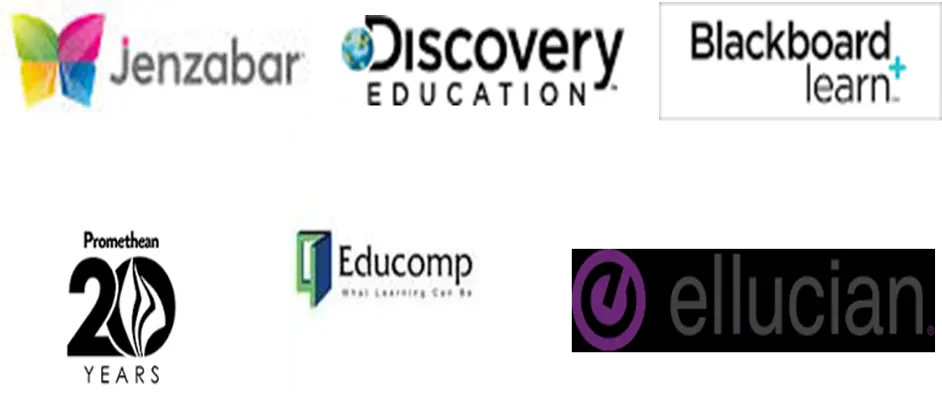Market Size of Digital Classroom Industry

| Study Period | 2019 - 2029 |
| Base Year For Estimation | 2023 |
| CAGR | 13.00 % |
| Fastest Growing Market | Asia Pacific |
| Largest Market | North America |
| Market Concentration | Low |
Major Players
*Disclaimer: Major Players sorted in no particular order |
Digital Classroom Market Analysis
The recent trend in the education delivery system has been evolving since the last few decades. The pedagogical system is effectively capitalizing on the opportunity to use technology to its fullest potential. Governments across the world are releasing funds and grants to support educational institutions to adopt modern and advanced methodologies to impart education. By doing so, governments can facilitate the digitization of educational systems in respective regions and countries. There is an increasing demand for digital education which drives the global digital classroom market. Digital classrooms are the modern classrooms that are equipped with integrated learning technologies including audience response technology, specialized software, and projectors, among others in order to deliver an enhanced learning experience. Additionally, the digital classroom is focusing on developing novel technologies in order to teach efficiently. This step would positively influence the e-learning market, allowing instructors to connect with their students. Recently, many educational institutions have increased the demand for digital content suitable for imparting the desired knowledge to students. Some schools with advanced ICT have already started adapting to online learning materials to reduce teachers' workload. In addition, the implementation of digital content is also to transform the whole traditional teaching methodology into more interactive and collaborative sessions. Also, as the cloud computing facilities help to minimize the expenditure on the information technology (IT) systems, the introduction of learning analytics and cloud computing in digital classrooms is anticipated to further drive the market growth in the forthcoming years
Digital Classroom Industry Segmentation
A complete background analysis of the global digital classroom market, which includes an assessment of the national accounts, economy, and the emerging market trends based on individual segments, significant changes in the market dynamics, and market overview, is covered in the report.
| By product | |
| Hardware | |
| Content | |
| Software |
| By Application | |
| K-12 | |
| Higher Education |
| By Geography | |
| North America | |
| Europe | |
| Asia-Pacific | |
| Latin America | |
| Middle East & Africa |
Digital Classroom Market Size Summary
The digital classroom market is experiencing significant growth as educational systems worldwide increasingly integrate technology into their pedagogical approaches. This shift is supported by government initiatives that provide funding and grants to educational institutions, encouraging the adoption of modern methodologies. Digital classrooms, equipped with advanced learning technologies such as audience response systems, specialized software, and projectors, are becoming the norm. These innovations aim to enhance the learning experience by making it more interactive and collaborative. The demand for digital education is rising, driven by the need for efficient teaching methods and the reduction of teachers' workloads through online learning materials. The incorporation of cloud computing and learning analytics is expected to further propel market growth by reducing IT costs and facilitating data-driven educational strategies.
The hardware segment remains dominant in the digital classroom market, with projectors leading due to their widespread use in education. Interactive whiteboards and displays are anticipated to grow rapidly. North America currently holds a leading position in the global market, supported by advanced educational technology and interactive learning systems. Meanwhile, the Asia-Pacific region is poised for substantial growth, driven by the adoption of digital classroom technologies in countries like India and China, alongside supportive government policies. The market is highly fragmented, with numerous local and regional players competing, including prominent companies such as Dell, Jenzabar, Blackboard, and Pearson Education. These companies, along with emerging startups, are intensifying competition in the rapidly evolving education sector.
Digital Classroom Market Size - Table of Contents
-
1. MARKET DYNAMICS AND INSIGHTS
-
1.1 Current Market Scenario
-
1.2 Market Dynamics
-
1.2.1 Drivers
-
1.2.2 Restraints
-
1.2.3 Opportunities
-
-
1.3 Industry Attractiveness - Porter's Five Forces Analysis
-
1.4 Value Chain/Supply Chain Analysis
-
1.5 Industry Policies and Regulations
-
1.6 Insights into the Type of Educational Institutions Using These Products
-
1.7 Insights into the Most Commonly Used Products
-
1.8 Insights into the Key Stakeholders - Manufacturers, Distributors, Traders, Wholesalers, and Downstream Vendors
-
1.9 Insights into the Key Business Strategies Used by the Edutainment Market Players and Service Providers
-
1.10 Technological Advancements
-
1.11 Advertising Strategies Implemented by the Market Players
-
1.12 Insights into the Innovative Strategies to Sell Different Services
-
-
2. MARKET SEGMENTATION
-
2.1 By product
-
2.1.1 Hardware
-
2.1.2 Content
-
2.1.3 Software
-
-
2.2 By Application
-
2.2.1 K-12
-
2.2.2 Higher Education
-
-
2.3 By Geography
-
2.3.1 North America
-
2.3.2 Europe
-
2.3.3 Asia-Pacific
-
2.3.4 Latin America
-
2.3.5 Middle East & Africa
-
-
Digital Classroom Market Size FAQs
What is the current Digital Classroom Market size?
The Digital Classroom Market is projected to register a CAGR of less than 13% during the forecast period (2024-2029)
Who are the key players in Digital Classroom Market?
Jenzabar, Discovery Education, Promethean World Ltd, Educomp, Ellucian and McGraw - Hill Education are the major companies operating in the Digital Classroom Market.

